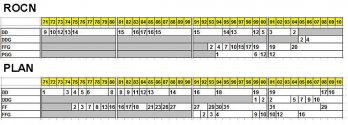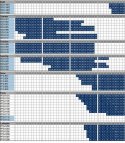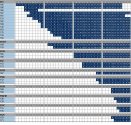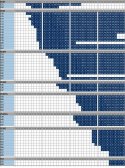It appears that some of the younger members are not quite familiar with the balance of military power across Taiwan Strait merely a quarter century ago.
I'll share some of the tables I made a few months ago.
This is the comparison of PLAN and ROCN in the period 1971-2010.
- DD - ROCN Fletcher, Sumner, Gearing / PLAN 051, 051G, 052, 051B
- DDG - ROCN Kidd / PLAN 956E, 052B, 051C, 956EM, 052C
- FF - PLAN 053K, 053H, 053H1, 053H2, 053H1G
- FFG - ROCN Knox, OHP, LaFayette / PLAN 053H2G, 053H3, 054
- PGG - ROCN missile corvettes
I did not include missile and torpedo boats because this would make the comparison more difficult but PLAN has decisive advantage in numbers of small combatants and submarines. The distinction between DD and DDG is the range and efficiency of organic air defenses. DDGs have SAMs with range of over 30km. ROCN DDs were modified to carry SM-1 but the performance was not ideal. The distinction between FF and FFG in PLAN is short range SAM.

Considering that ROCN DDs had only limited AAW with added SM-1s the situation is not as clear until the 1990s. PLAN has slight numerical advantage but ROCN has better technology on its ships. In the 1990s Taiwan acquires OHP frigates which give it temporary advantage which is then nullified by PLAN DDGs with Buk a decade later.
Here's a more detailed breakdown - hopefully the forum's engine won't make it too illegible. The numbers on blue fields denote the ship's age during service in the navy.
ROCN destroyers and frigates 1971-2010:

Fletcher, Sumner and Gearing destroyers were modernized in 1990s to add 10 SM-1 in slanted canisters, Hsiung Feng II missiles and one 8-cell ASCROC launcher. SM-1 launchers were moved to Knox frigates which also use slanted SM-1 canisters.
PLAN destroyers 1971-2010:

Before modernization 052 and 051B had HQ-7 which put them in the same category in terms of AAW as 051G. 956E was the first destroyer with proper area defense. Older 051 - development of Soviet Kotlin-class - were just anti-surface and ASW ships with minimal AAW and had protection provided by PLANAF/PLAAF aircraft.
PLAN frigates 1971-2010:

053H2G, 053H3 and 054 are the first "modern" frigates with short-range SAM. The older variants are ASW and anti-surface developments of Soviet Riga class.
As for air force the situation also wasn't nearly as obvious, although ROC's advantage was more explicit
when it occured. ROC never had sufficient number of missile boats or submarines to contend with PLAN but it acquired greater capabilities than PLAAF/PLANAF during its period of advantage.
150 F-16s were bought along with 60 Mirage 2000s in 1992 as reaction to PLA's acquisition of Su-27s. Mirage 2000 were delivered 1997-1998 and F-16s were delivered 1997-2001. In the same period Taiwan built 130 F-CK-1s. In 1995 ROC made the most important acquisition of four E-2s. All that combined, along with domestic HF anti-ship missiles for F-CK-1s, provided a very potent force at the time. But the advantage was essentially gone in the latter half of the 2000s as PLAAF got their KJ-2000 and KJ-200 and increased the number of J-11s and J-10s on top of Su-27/30s.
In conclusion: Taiwan had a short buildup in the 90s when it capitalized on its economic strength and this buildup gave ROC military short-lived
advantage in the period of 1998-2005. Afterward the balance of powers returned to its natural trajectory and became dependent on US power projection. We can speculate on the level of skill and morale among ROC military but that's a separate problem. The numbers are what they are.
It seems that how you perceive the balance of powers is probably more of a sign of your age and origin, being more of a feeling of where each country is going and what its future is that what really happened. To me those several years of ROC advantage are a historical blip like the advantage Germany had in early WW2. They might seem significant from a subjective human perspective because humans remember points in time that are characterized by strong emotional value. Taiwan surging forward in the 1990s is such moment. That China caught up very quickly is not remembered because after 2001 everyone was looking elsewhere and after 2008 the rapid military expansion of China seems to come from "nowhere". Except that's precisely what was going on in the 1990s and 2000s.
By PLANAF’s own admission, Su-30MK2/R-77 combo is vastly weaker than J-10AH/PL-12, so much so that in DACT training the J-10 is responsible for handling targets in BVR. This doesn’t bode well for the Su-30 in a match up against the F-16 unless it is WVR.
What's "WVR" for Su-30M using IRST and long-range IR-guided missiles like R-27ET? In any case F-16 has consistent advantage at all distances, especially if it uses AIM-120 because it has better radar. Su-30 has advantage of energy at higher ceilings but not of maneuverability because it is far less maneuverable than Su-27 which is worse than F-16 or F-15. Su-27M a.k.a Su-35 included modifications to airframe because the original design seriously under-performed.
Su-30 was never meant to be an air superiority fighter until India ordered Su-30MKI. It was developed from Su-27UB as a multirole fighter with emphasis on strike missions. After the dissolution of USSR work on Su-27M (Su-35) ad Su-34 stopped and Sukhoi began to promote Su-30 as a middle of the road solution first for RuAF then for export. Even after MKI proved successful Russia never used Su-30 as air superiority fighters because it had MiG-31 and Su-27M. Su-30SM was ordered as a strike fighter with greater multirole capability than Su-34 which was a tactical bomber replacing Su-24M and some of Tu-22M.
Su-30s had poor radar because Russian technology couldn't produce lighter phased arrays which is why Bars used in MKI forced the addition of canards. Because of lag in technology Su-27s had radar worse than AN/APG-66 used in F-16A/B and that didn't change until funding from MKI helped with R&D. Only now Su-30SM in Russian Air Force are being equipped with N035 Irbis-E because this is how long it took for Russia to catch up in manufacturing.
Chinese Su-30s were revolutionary for PLA at the time, much like Su-27s and J-11A but that was only because PLA was frozen in time in the 80s. As soon as that was changed and necessary steps were taken for domestic development of technology Su-30 was obsolete within a decade. Su-30s are used because they're new and useful in strike roles. Not because they're good.
Russian PR always sounds like you're getting the new Sputnik revolution but in reality China, Malaysia and Indonesia complained about Su-30s. Only India is pleased but that needs to be understood in its own terms.




